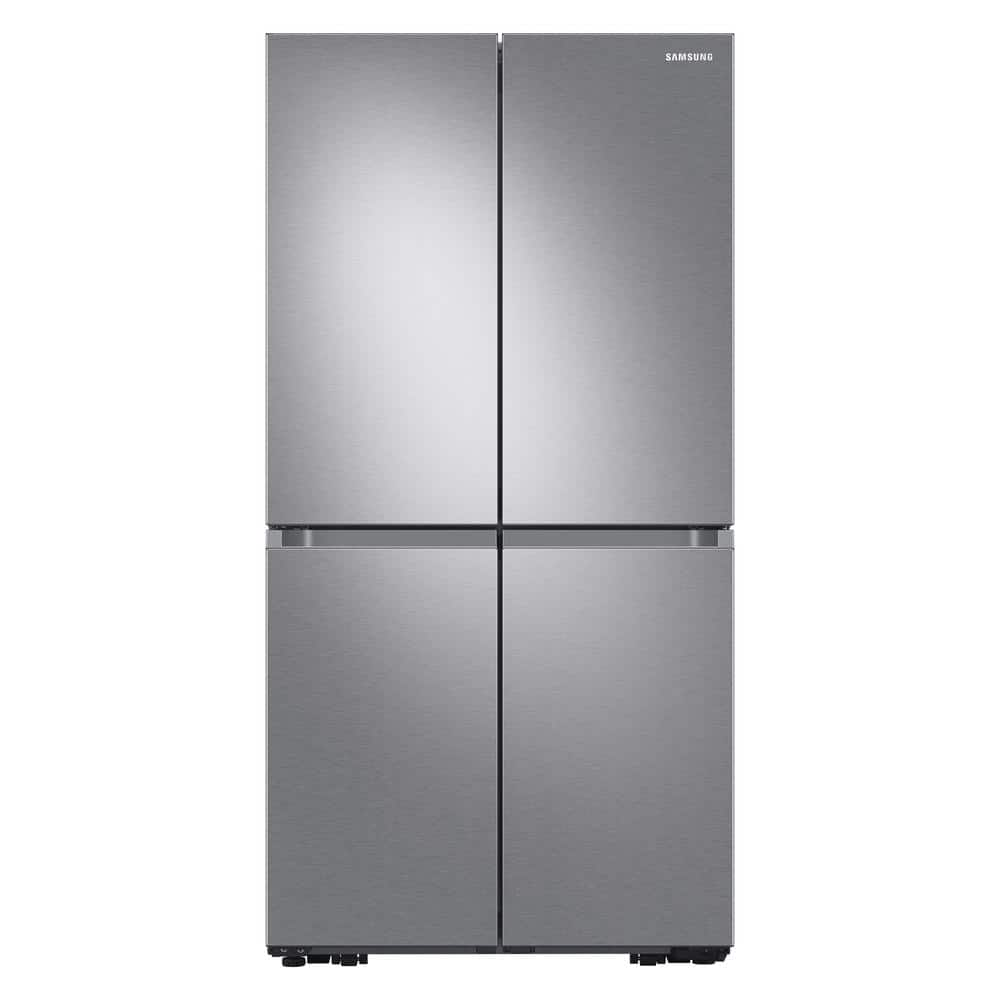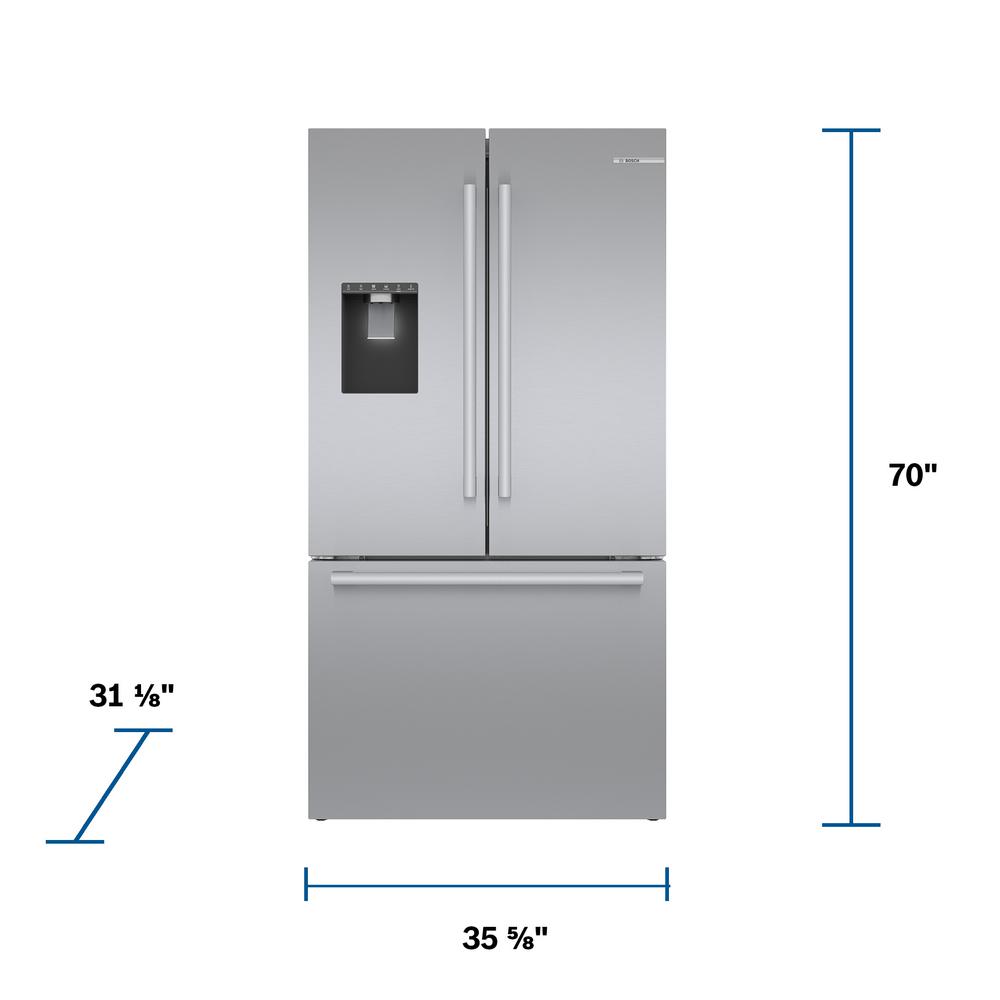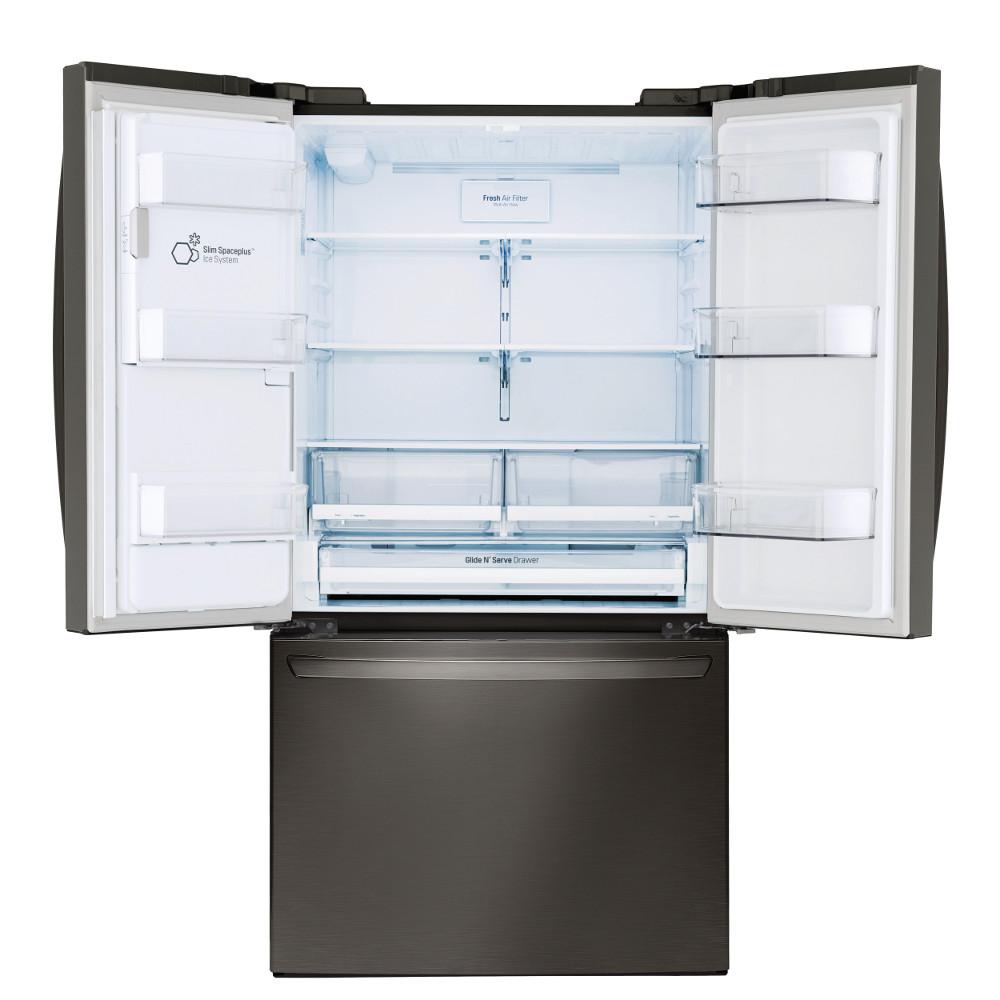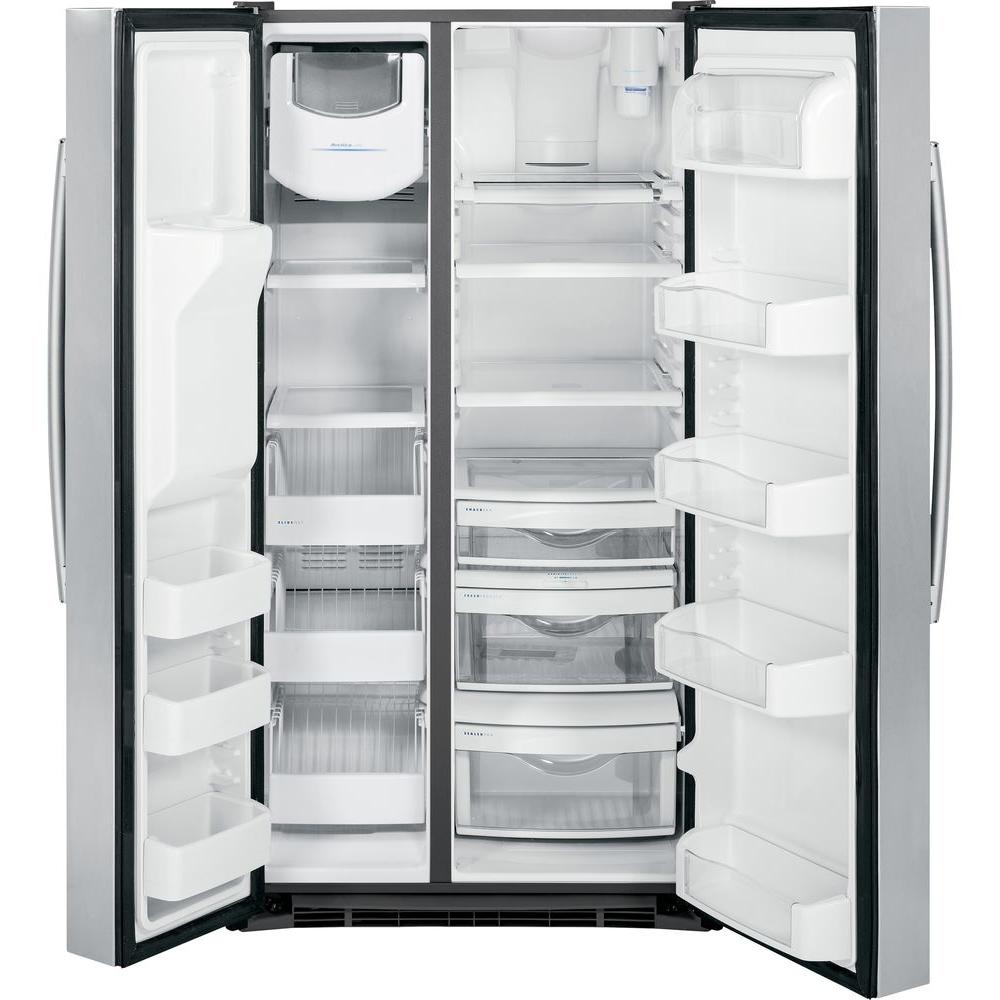Samsung 29 cu. ft. 4-Door Flex French Door Refrigerator in Fingerprint Resistant Stainless Steel with FlexZone
Internal water dispenser and built-in AutoFill Water Pitcher. Dual Ice Maker with Ice Bites.
Easily convert from fridge to freezer to meet your family’s needs.
Samsung’s extra-large capacity Smart 4-Door Flex refrigerator features the Beverage Center with both a water dispenser and AutoFill Water Pitcher. It includes a Dual Ice Maker with Ice Bites, smaller nugget ice. Flexzone allows you to easily convert from fridge to freezer temperatures with flexibility to meet your family’s food storage needs.
- Quick access to refreshingly cool, filtered water 2-ways, choose from an internal dispenser or a built-in pitcher that automatically refills, with the option to infuse with a flavor
- Enjoy your favorite beverage with your choice of ice, select from cubed ice or new nugget-style Ice Bites that chill your drink faster
- Customize your lower-right storage space to be refrigerator or freezer, with 5-adjustable settings, you choose what foods to store from fruits and vegetables to your favorite ice cream
- 29 cu. ft. of flexible storage space to fit all the food you love, with room for more
- Modern, built-in look that blends seamlessly into your kitchen
- Flex Crisper, a flexible storage drawer that is perfect for storing meats, veggies, or cheeses at their optimal temperature with two customizable temperature settings
- Keep the air in your fridge fresh day after day with a built-in deodorizing filter with UV technology that continuously cleans the filter itself
- Treated with antimicrobial technology to deliver long-lasting protection of high-touch handle surfaces, antimicrobial treatment does not protect users or other items against bacteria, viruses, germs, or other disease organisms
- Triple Cooling is a premium cooling system that features 3-evaporators for ultimate freshness and providing precise temperature and humidity controls in all 3-zones to help your food stay fresher longer
- Fingerprint Resistant finish with stands everyday smudging
- Also available in Fingerprint Resistant Black Stainless Steel
- ENERGY STAR
Additional information
| Depth (Excluding Handles) | 33.9 |
|---|---|
| Depth (Including Handles) | 33.9 |
| Depth (Less Door) | 29.4 |
| Depth With Door Open 90 Degrees (In) | 48.5 |
| Height to Top of Door Hinge (in.) | 71.8 |
| Height to Top of Refrigerator (in.) | 70.75 |
| Product Depth x Height x Width (in.) | 33.8 x 71.8 x 35.8 |
| Refrigerator Width (In.) | 35.8 |
| Certifications and Listings | ADA Compliant,Energy Star |
| Manufacturer Warranty | Five (5) years Parts and Labor on sealed Refrigeration system only* Ten (10) years Part and Five (5) years Labor on Digital Inverter Compressor (*Compressor, evaporator, condenser, drier, connecting tubing) |






by John
We are so happy to be able to test this Samsung 4 Door Flex. We received our 29 cu. ft. Smart 4-Door Flex™ Refrigerator with Beverage Center & Dual Ice Maker last week and we love it. The best part is the dual ice maker, my husband has many networking events and makes cocktails at home and loves the fact that the ice maker makes little ice cubes for cocktails. Another huge plus on this fridge is the beverage center, it fills up on its own every time we never have to fill up ourselves. One of the plastic container holders came cracked so we do not know who to contact to get that replaced but besides that, this is the best fridge ever! We also love the fact that we do not get any fingerprints as it is fingerprint resistant. Another great feature this refrigerator has is the 2 minute door alarm. I love the alarm because sometimes my mom who is older, comes over to our home and goes to refrigerator and leaves the door open. With this 2 minute alarm, it has already warned me a couple times that she has left one of the doors or the freezer open. So far some of my friends that have come over love the size of the fridge, it is very big and the LED lights it has are brighter than any I have had before. You can see perfectly into the fridge, no matter how way back something may be (the depth is great). This is one of my favorite refrigerators I have ever purchased. I am recommending to all my friends! I posted it in facebook and got so many questions about it.
by Chris
I am loving the amount of room that this fridge has. My old fridge was 22 cu. feet so I have plenty of extra space in the fridge section but the same amount in the freezer sections. I feel that I am able to organize my food better in the new fridge and the pull out shelves make it easy to see what I have in the freezer. My family is loving the dual ice makers and the beverage section in the door. The digital controls for the temperature are also easy to use. Through the controls, I can adjust the temperature turn on the ice makers and more. I like that I can choose to use one of the ice makers or both. I also like that I can store my milk on the fridge door. At first, I was not liking that the shelves in the fridge don’t have many options for different places and that there were only 2 drawers. I solved that problem with using baskets in the fridge area. So I can organize my food better. Opening the doors took a while to remember to grab under the door. I also like how easy it is to change the water filter as it is inside the fridge. So no more having to lay on the floor to change the water filter.
by Vanfig
I have had this refrigerator for more than a month and I LOVE it! The space in the refrigerator is very large and is way more than I need, but it is great to have the added space when I need it occasionally. The look and design is amazing. I chose the color Blue and it definitely stands out in our kitchen. It is now the first thing that people notice when they come into our kitchen. I was first a little concerned about the size of the freezer, I though it might not be enough space, but now I have way more space than I need. In my last freezer, it was filled to the rim, and now I barely use 1 side completely and about a fifth part of the second freezer area. I love that the drawers in the freezer slide out because it makes storage so much easier and I can organize the food so much better. The best part of this fridge has definitely been the Dual Ice Maker! Every single person that I show it to is amazed and immediately say they want one too. The only negative review I have about this refrigerator is that although the ice maker is my favorite feature, it does take about 24 hours to completely fill the ice containers after being empty. I previously had a Samsung refrigerator and was very disappointed with it, but this refrigerator has been the best upgrade in appliances I have made.
by Hodge
This really is a great fridge. After you’ve taken off the doors so it will fit through your doorways and you plug it in, it will be somewhat overwhelming with how bright it is and how many bins there are to unwrap, but you get used to the light and are excited at how much space there is for everything. If you need more fridge than freezer space, one of the bottom areas can be changed to a fridge space or is even specific to meat/fish, fruit/veggies, or beverages. My last fridge was 17 cu. ft. and this one is 29 so there is sooo much more space! It’s quite large for where it is but I’m in the early stages of renovating so it will have to move to a new area. The ability to sync with the SmartThings app will allow you to change the temperature of the fridge or freezer, change the FlexZone or Flex Crisper, turn on or off ice bites or cubed ice, and to power freeze or power cool for initial cool-down. It will even tell you if your door is open or will beep so you can hear it if you’re home. If changing these settings on the inside, I think it could take awhile and would cause the unit to start beeping due to the door being open for too long. The auto-fill pitcher is great to have if you want very cool water without having ice or you have company over. I love the option of having two different types of ice and to infuse water in the pitcher. The drawers glide with ease and the counters and bins are very spacious. The black stainless look is very modern and fits well with the other Samsung appliances. My only gripe is that right now I’m getting flakes in my glass from the ice cubes melting. Not sure if that can be fixed since this is my first fridge with water hook-up.
by Nick
We are extremely happy with our BESPOKE refrigerator and glad we made the purchase. The navy glass panels are so beautiful and knowing they can be swapped out with other colored panels in the future is a plus! The fridge has sooo much room and can store a lot of food in both the refrigerator and freezer section. Two of our favorite things about the fridge are the ice bites and the water filter jug that refills on its own. Would recommend to anyone!
by Jity
I LOVE this fridge!
by Wayne
Great addition to our kitchen.
by Jono
I love this refrigerator!